Deep-sea Debris in the Western and Central Pacific
June 25, 2020
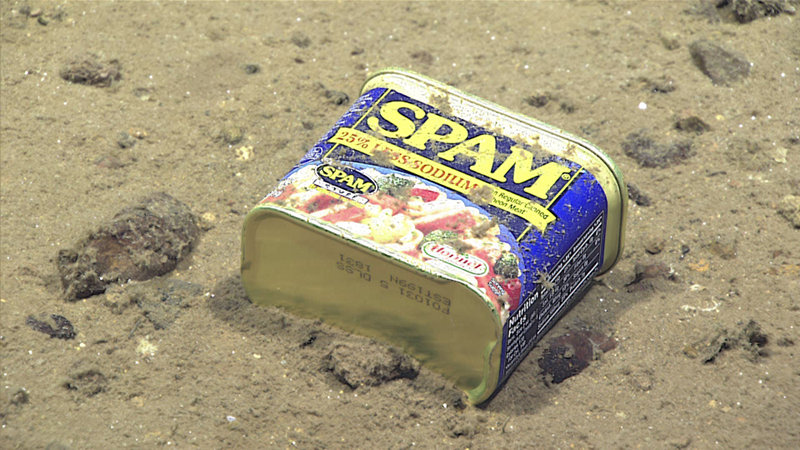
Metal debris – a food tin found at 4,947 meters (3.07 miles) depth in Sirena Canyon off the Mariana Islands. Image courtesy of the NOAA Office of Ocean Exploration and Research, 2016 Deepwater Exploration of the Marianas. Download larger version (1.4 MB).
While deep-ocean exploration is responsible for ground-breaking discoveries, it is also unmasking the true scale of our impacts in the deep ocean. Marine debris is a growing problem and a new study has shown that even unexplored, remote, and protected areas of the central and western Pacific deep ocean are not immune from our touch.
Coordinated deepwater exploration from 2015 to 2017 via remotely operated vehicle expeditions conducted onboard NOAA Ship Okeanos Explorer and the Schmidt Ocean Institute’s Research Vessel Falkor enabled new insights into the status of deep-sea marine debris. These expeditions included exploration of sites within U.S. protected areas and monuments, Exclusive Economic Zones of other countries, international protected areas, and areas beyond national jurisdiction.
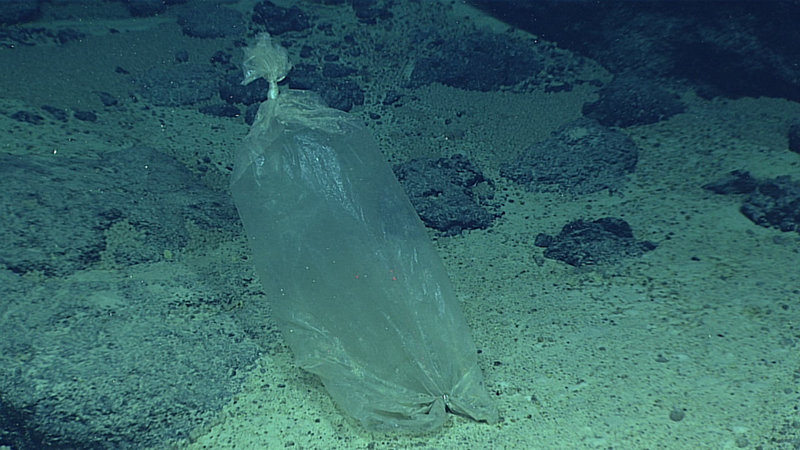
Plastic debris – a plastic bag at 3,767 meters (2.34 miles) depth on Enigma Seamount off the Mariana Islands. Image courtesy of the NOAA Office of Ocean Exploration and Research, 2016 Deepwater Exploration of the Marianas. Download larger version (1.2 MB).
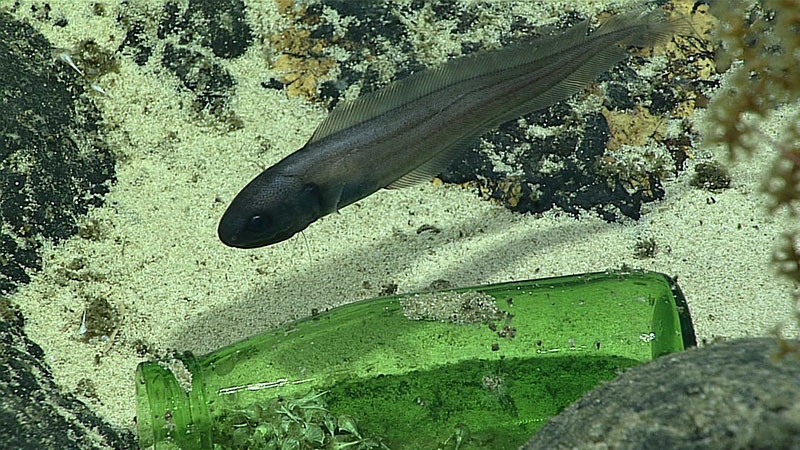
Glass debris – a glass bottle at 1,152 meters (3,780 feet) depth at Titov Seamount in the Howland and Baker Unit of the Pacific Remote Islands Marine National Monument, now known as Pacific Islands Heritage Marine National Monument. Image courtesy of the NOAA Office of Ocean Exploration and Research, Discovering the Deep: Exploring Remote Pacific MPAs. Download larger version (456 KB).
Metal, glass, plastic, rubber, cloth, fishing gear, and other debris were encountered during 17.5 percent of the 188 dives reviewed, at depths between 150 and 6,000 meters (492 and 19,695 feet). While this percentage may seem low, in some areas such as off American Samoa, the densities of debris were as high as 196–1,961 items per square kilometer. This patchy distribution is likely influenced by depth, geological features such as seamounts, the proximity to areas with dense human populations, and past conflict in the region, with 5.2 percent of debris observed consisting of bullets, bombs, and other war-related items.
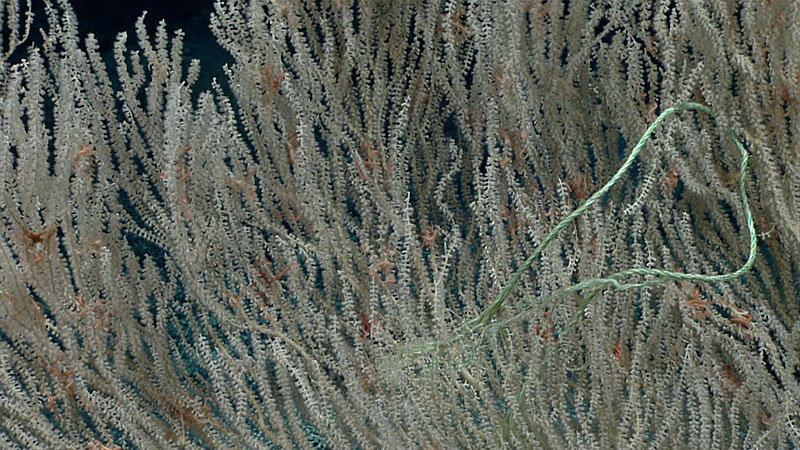
Fishing line entangled in a large primnoid coral at 1,772 meters (6,5814 feet) depth in the Musician Seamounts in Areas Beyond National Jurisdiction. Image courtesy of the NOAA Office of Ocean Exploration and Research, Deep-Sea Symphony: Exploring the Musicians Seamounts. Download larger version (411 KB).
Of the debris observed, 39.13 percent were directly impacting deep-sea life, including corals entangled with fishing gear. However, not all interactions appeared to be negative; some animals used debris for shelter or as substrate to attach to. Additionally, as these observations were only of debris larger than 2 centimeters (0.79 inches) in size, there are likely many unseen impacts, such as from microplastics and chemicals leaching out of debris.
The naturally slow biological and chemical processes operating at depth, coupled with the types of materials that are used commercially, suggest that debris is likely to persist in the deep ocean for long periods of time, ranging from hundreds to thousands of years, making these results quite alarming, especially as use of the deep ocean is increasing.
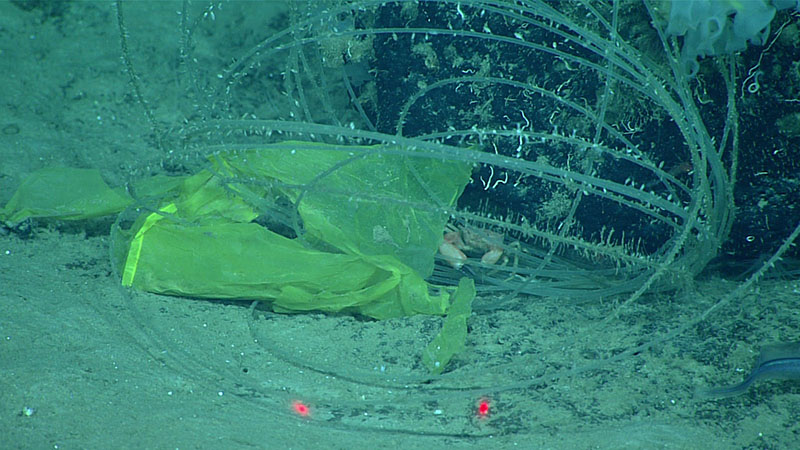
A plastic bag and fishing line providing shelter for a crab and substrate for cirripeds (barnacles) at 791 meters (2,595 feet) off the main Hawaiian Islands. Image courtesy of the NOAA Office of Ocean Exploration and Research, 2015 Hohonu Moana. Download larger version 278 KB).
This study serves as a reminder that we need to take steps to reduce the flow of debris into the marine environment through working to stem the debris tide at point sources, reverting to a circular economy, innovating away from single use materials, and ultimately consuming less. To learn more about marine debris impacts and how you can help, visit: https://marinedebris.noaa.gov/.
Text contributed by Diva Amon, Department of Life Sciences, Natural History Museum, London, United Kingdom.
Amon DJ, Kennedy BRC, Cantwell K, Suhre K, Glickson D, Shank TM and Rotjan RD (2020) Deep-Sea Debris in the Central and Western Pacific Ocean. Front. Mar. Sci. 7:369. doi: 10.3389/fmars.2020.00369 .
Related
Earth Day2 - Encounters with Trash - 2016 Deepwater Exploration of the Marianas